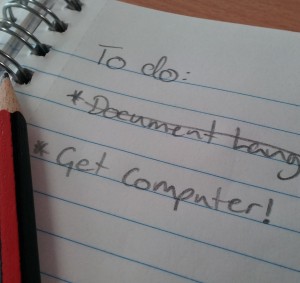ExSite9 is an open-source cross-platform tool for creating descriptions of files created during fieldwork. We have been working on the development of ExSite9 over the past year and it is now ready for download and use: http://www.intersect.org.au/exsite9 https://github.com/IntersectAustralia/exsite9/wiki/Install-packages
ExSite9 collects information about files from a directory on your laptop you have selected, and presents it to you onscreen for your annotation, as can be seen in the following screenshot. The top left window shows the filenames, and the righthand window shows metadata characteristics that can be clicked once a file or set of files is selected.The manual is here: http://bit.ly/ExSite9Manual
Researchers who undertake fieldwork, or capture research data away from their desks, can use ExSite9 to support the quick application of descriptive metadata to the digital data they capture. This also enables researchers to prepare a package of metadata and data for backup to a data repository or archive for safekeeping and further manipulation.
Scholars in the Humanities, Arts and Social Sciences (HASS) typically need to organise heterogeneous file-based information from a multitude of sources, including digital cameras, video and sound recording equipment, scanned documents, files from transcription and annotation software, spreadsheets and field notes.
The aim of this tool is to facilitate better management and documentation of research data close to the time it is created. An easy to use interface enables researchers to capture metadata that meets their research needs and matches the requirements for repository ingestion.
Read more
 Follow
Follow There are a (very) few linguists who advocate that researchers should go to the field with nothing beyond a spiral-bound notebook and a pen, though no one at the table was quite willing to go that far; all of us, it seems, go to the field with a good quality audio recorder at the very least. Without the additional recordings (be they audio or video) the only output of the research becomes the final papers written by the linguist, which are in no way verifiable. The recording of verifiable data, and the slowly increasing practice of including audio recordings in the final research output are allowing us to further stake our claim as an empirical and verifiable field of scientific inquiry. Many of us shared stories of how listening back to a recording that we had made enriched the written records that we have, or allow us to focus on something that wasn’t the target of our inquiry at the time of the initial recording. The task of trying to do the level of analysis that is now expected for even the lowliest sketch grammar is almost impossible without the aid of recordings, let alone trying to capture the subtleties present in naturalistic narrative or conversation.
There are a (very) few linguists who advocate that researchers should go to the field with nothing beyond a spiral-bound notebook and a pen, though no one at the table was quite willing to go that far; all of us, it seems, go to the field with a good quality audio recorder at the very least. Without the additional recordings (be they audio or video) the only output of the research becomes the final papers written by the linguist, which are in no way verifiable. The recording of verifiable data, and the slowly increasing practice of including audio recordings in the final research output are allowing us to further stake our claim as an empirical and verifiable field of scientific inquiry. Many of us shared stories of how listening back to a recording that we had made enriched the written records that we have, or allow us to focus on something that wasn’t the target of our inquiry at the time of the initial recording. The task of trying to do the level of analysis that is now expected for even the lowliest sketch grammar is almost impossible without the aid of recordings, let alone trying to capture the subtleties present in naturalistic narrative or conversation.